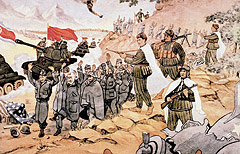Remnants of Chinese art can be found dating back to approximately 2000 B.C. in the form of red ceramic pots decorated with straight or undulated lines.
Chinese handcraft stands out in the areas of weaving and porcelain. The most commonly worked fabric in weaving was silk, which was mainly used in tapestries and imperial clothing. It was obtained from the bombyx-mori (silkworm of the mulberry tree) and its production, through procedures which were kept secret for hundreds of years, extended to a great part of China.
The production of porcelain in China began a little more than one thousand years ago using kaolinite (a very pure white clay) that was baked and vitrified (to give it a glass-like appearance) at very high temperatures, making it transparent and impermeable.
This handcraft reached its perfection during the Tang Dynasty (618-907 A.D.) with the immaculate whites of Xing, although its greatest diffusion took place in the Ming Dynasty (1368-1644). These pieces were so delicate that they could be read through.
Contemplative Painting
The technique of Chinese painting consisted of applying watercolours to silk or paper with a brush, in such a way that it could not be corrected. Frescoes were also painted on the walls of the palaces. It is probable that they were of a sacred origin and they go back to 200 years B.C. From the 6th century the basic principles of the pictorial process were organized and a remarkable level of expression was reached due to the Chan Buddhist influence during the Tang Period. Here the characters appear small inside a dominating natural environment, representing at the same time, Buddhist restraint and the natural simplicity of Taoism.
During the rule of the Mongols, painting was mannerist, and, under the Ming and Qing dynasties maintained its perfection, despite distancing itself from the older masters. In the first half of the 20th century Western techniques such as oil were introduced, and the themes, focused upon, became more social.
Fertile Literature
Chinese literature was abundant and very creative. Its authors possessed a world view which was more intuitive and subjective than rational, therefore a number of literary genres arose, also based on the ever more frequent use of everyday language.
Its beginnings are found in the second millennium B.C. One of the oldest texts is the «Book of Origins«, which narrated the existence of the first Chou sovereigns. The author, Tchouang Tseu organized the teachings of Taoism in an educative way in the 3rd century B.C. These consisted of inner reflection and the attainment of perfection through isolation from the world. Their founder was Lao Tse (or Lao Tsu). For their part, the followers of Confucianism edited «The Unchanging Path» and «The Great Study«.
Classical Chinese Poetry reached its peak during the Tang Dynasty. Authors such as Du Fu (712-770) and Li Taipo (701-762) stood out with themes which touched upon natural mysteries. «Dream in the red pavilion» by Cao Xuequin (1717-1763) is considered to be the most memorable novel.
Different Music
Traditional Chinese music, having its origins in sacred, aristocratic and popular themes, is distinct from western music because of its rhythm, beat and tones. This is explained by the traditional instruments used to make melodies, and the fact that it dates back approximately two thousand years. The most appreciated by Taoists during the Tang Dynasty was the lute, even more than the bamboo flute, which had a melancholy sound.
Currently, some of the most used instruments are gongs, the pipe (a lute of four chords) and the qin (a zither of seven chords). Theatrical music, developed in the imperial court, was either civilian or military.
Balanced Architecture
The particular characteristics of Chinese architecture took shape in the epoch of the Zhou Dynasty (1027-256 B.C.) where functionality and pure aesthetics were combined.
Houses, built mainly of wood, were built above a stone parquet floor and a column was used as a form of support. Roofs had large curved eaves and tiles were painted in different colours. The buildings were balanced and made up of a single storey. They were designed to blend in with their natural surroundings and usually included gardens.
In Chinese Architecture the Great Wall, which began to be constructed during the Ch’in Dynasty (221 B.C.-207 B.C. approximately) and the Forbidden City of Beijing (Peking) which was built during the Ming Dynasty, stand out especially.
Chinese Medicine
One of the most striking aspects of Chinese culture is its traditional medicine which is basically preventative, as opposed to Western medicine which is basically reactive in nature. This means that Eastern medicine, instead of attacking and trying to cure an already discovered disease, prevents it.
The foundation of this method is that mind and body should be in harmony, as should the spirit with its surroundings.
A sickness, so then, would be due to an imbalance in this equilibrium, which manifests itself by blocking the meridians or channels of the body through which energy circulates.
Among the disciplines of Chinese medicine can be found digipuncture, aromatherapy, naturalism, reflexology and acupuncture (see figure).








 Termina la Guerra de Corea
Termina la Guerra de Corea